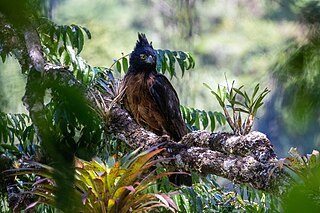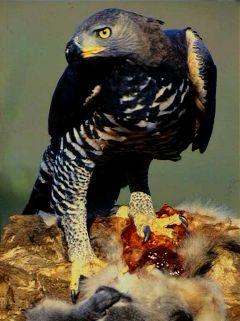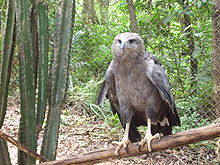
Eagle is the common name for the golden eagle, bald eagle, and other birds of prey in the family Accipitridae. Eagles belong to several groups of genera, some of which are closely related. True eagles comprise the genus Aquila. Most of the 68 species of eagles are from Eurasia and Africa. Outside this area, just 14 species can be found—two in North America, nine in Central and South America, and three in Australia.

The Accipitridae is one of the three families within the order Accipitriformes, and is a family of small to large birds of prey with strongly hooked bills and variable morphology based on diet. They feed on a range of prey items from insects to medium-sized mammals, with a number feeding on carrion and a few feeding on fruit. The Accipitridae have a cosmopolitan distribution, being found on all the world's continents and a number of oceanic island groups. Some species are migratory. The family contains 255 species which are divided into 70 genera.

The harpy eagle is a neotropical species of eagle. It is also called the American harpy eagle to distinguish it from the Papuan eagle, which is sometimes known as the New Guinea harpy eagle or Papuan harpy eagle. It is the largest and most powerful bird of prey found throughout its range, and among the largest extant species of eagles in the world. It usually inhabits tropical lowland rainforests in the upper (emergent) canopy layer. Destruction of its natural habitat has caused it to vanish from many parts of its former range, and it is nearly extirpated from much of Central America. In Brazil, the harpy eagle is also known as royal-hawk. The genus Harpia, together with Harpyopsis and Morphnus, form the subfamily Harpiinae.

The grey-headed fish eagle is a fish-eating bird of prey from South East Asia. It is a large stocky raptor with adults having dark brown upper body, grey head and lighter underbelly and white legs. Juveniles are paler with darker streaking. It is often confused with the lesser fish eagle and the Pallas's fish eagle. The lesser fish eagle is similar in plumage but smaller and the Pallas's fish eagle shares the same habitat and feeding behaviour but is larger with longer wings and darker underparts. Is often called tank eagle in Sri Lanka due to its fondness for irrigation tanks.

The Taita falcon is a small falcon found in central and eastern Africa. It was first described from the Taita Hills of Kenya from which it derives its name.

The white-eyed buzzard is a medium-sized hawk, distinct from the true buzzards in the genus Buteo, found in South Asia. Adults have a rufous tail, a distinctive white iris, and a white throat bearing a dark mesial stripe bordered. The head is brown and the median coverts of the upper wing are pale. They lack the typical carpal patches on the underside of the wings seen in true buzzards, but the entire wing lining appears dark in contrast to the flight feathers. They sit upright on perches for prolonged periods and soar on thermals in search of insect and small vertebrate prey. They are vociferous in the breeding season, and several birds may be heard calling as they soar together.

The pichi, dwarf armadillo or pygmy armadillo is an armadillo native to Argentina. It is the only living member of the genus Zaedyus, and the only armadillo to hibernate. Fossil remains from the Cerro Azul Formation indicate this species had already evolved during the late Miocene epoch.

The black-breasted buzzard is a large raptor endemic to mainland Australia. First described by John Gould in 1841, it forms part of the family Accipitridae and is most closely related to the square-tailed kite. It is a versatile hunter known for its special skill in cracking eggs. The species is common throughout most of its range.

The solitary eagle or montane solitary eagle is a large Neotropical eagle. It is also known as the black solitary eagle.

The crested eagle is a large Neotropical eagle. It is the only member of the genus Morphnus. The crested eagle can grow up to 89 cm (35 in) long, with a wingspan up to 176 cm (69 in), and weigh up to 3 kg (6.6 lb). The plumage varies between a light brownish-gray to sooty gray or even blackish in some cases. It has a white throat and a dark spot on the crest and a small dark mask across the eyes. It ranges extensively throughout Central and South America, but not in large numbers. favoring tropical lowland forest. A powerful predator, its diet consist mainly of small mammals, rodents, snakes and smaller birds. Despite their large distribution, they are currently classified as Near Threatened by the IUCN, due mainly to habitat loss

Buteogallus is a genus of birds of prey in the family Accipitridae. All members of this genus are essentially neotropical, but the distribution of a single species extends slightly into the extreme southwestern United States. Many of the species are fond of large crustaceans and even patrol long stretches of shore or riverbank on foot where such prey abounds, but some have a rather different lifestyle. Unlike many other genera of raptor, some members are referred to as "hawks", and others as "eagles".

The black-and-chestnut eagle is a large South American species of bird of prey in the family Accipitridae. It is sometimes called Isidor's eagle. It is often placed in the monotypic genus Oroaetus. However, recent genetic testing indicates that this species is fairly closely related to Spizaetus species and thus the species should be included in that genus. The black-and-chestnut eagle is a typical forest raptor, hunting primarily small to medium-sized mammals and birds and constructing a large nest in a tall tree. Unfortunately, the twin causes of habitat destruction and persecution, justified or not as an occasional poultry killer, have caused strong population declines and the black-and-chestnut eagle is considered to be an Endangered species by the IUCN.

Woodward's eagle is an extinct species of black hawk that lived in North America and the Caribbean during the Late Pleistocene. Remains have been found in the La Brea Tar Pits in the United States and in Cuba. Despite the common name, the species is technically a gigantic variety of hawk as it is a member of the still extant black hawk genus, Buteogallus, within the Buteoninae subfamily that are chiefly referred to as hawks, and not the Aquilinae subfamily most eagles belong to.

The common black hawk is a bird of prey in the family Accipitridae, which also includes the eagles, hawks, and vultures.

The red-shouldered hawk is a medium-sized buteo. Its breeding range spans eastern North America and along the coast of California and northern to northeastern-central Mexico. It is a permanent resident throughout most of its range, though northern birds do migrate, mostly to central Mexico. The main conservation threat to the widespread species is deforestation.

The crowned eagle, also known as the African crowned eagle or the crowned hawk-eagle, is a large bird of prey found in sub-Saharan Africa; in Southern Africa, it is restricted to more easterly areas. Its preferred habitats are principally riparian woodlands and various forests. The crowned eagle is the only extant member of the genus Stephanoaetus. A second species, the Malagasy crowned eagle, went extinct after early humans settled on Madagascar.

At one time, the golden eagle lived in a great majority of temperate Europe, North Asia, North America, North Africa, and Japan. Although widespread and quite secure in some areas, in many parts of the range golden eagles have experienced sharp population declines and have even been extirpated from some areas. The total number of individual golden eagles from around the range is estimated to range somewhere between 170,000 and 250,000 while the estimated total number of breeding pairs ranges from 60,000 to 100,000. Few other eagle species are as numerous, though some species like tawny eagle, wedge-tailed eagle and bald eagle have total estimated populations of a similar size to the golden eagle's despite having distributions which are more restricted. The world's most populous eagle may be the African fish eagle, which has a stable total population estimated at 300,000 individuals and is found solely in Africa. On a global scale, the golden eagle is not considered threatened by the IUCN.

The Paraná flooded savanna (NT0908) is an ecoregion that borders the southern Paraná River in Argentina. It has largely been converted to agriculture or occupied by urban development, but scattered patches of the original habitat remain along the river.

The Argentine Monte (NT0802), or Low Monte, is an ecoregion of dry thorn scrub and grasslands in Argentina. It is one of the driest regions in the country. Human settlements are mainly near water supplies such as rivers or oases. Deforestation and over-grazing around these settlements have caused desertification.

In the United Kingdom, raptor persecution is a crime against wildlife. The offence includes poisoning, shooting, trapping, and nest destruction or disturbance of birds of prey.
























